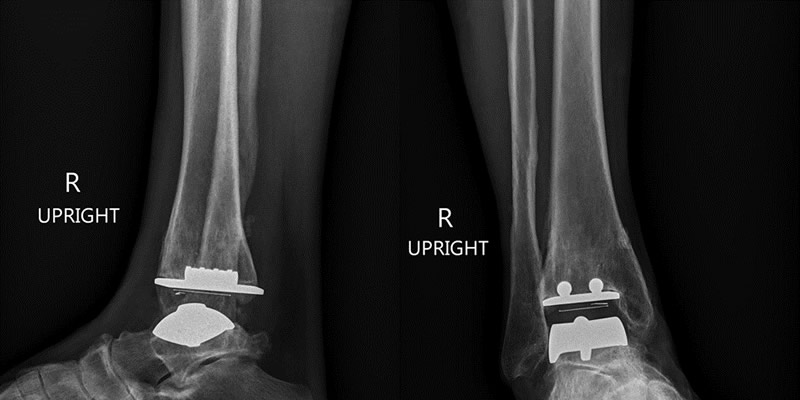
Dr. Kleiber Saves Highway Patrol Officer From Early Retirement
Patty Peiffer knew what she wanted to do with her life. She wanted to be a member of the Missouri State Highway Patrol. When she was at the Highway Patrol Academy in 1993, she dislocated and fractured her right ankle. She had surgery to repair it and went on to serve six years on the Patrol.
When a patient has a bad injury to the ankle joint like Patty's injury, the cartilage in the joint may eventually deteriorate leading to degenerative arthritis in the joint. As arthritis progresses, there is often the development of increasing pain and stiffness in the ankle. Even simple activities such as normal walking can become much more difficult because of the pain occurring with movement of the ankle. In addition, the arthritic ankle often develops significant stiffness.
For many years the only surgical option for a severely arthritic ankle that could offer some pain relief was an ankle fusion. In an ankle fusion, the bones of the ankle which used to move against each other are intentionally surgically fused to each other to eliminate the movement, since the movement is what is so painful. Unfortunately, however, an ankle fusion makes the ankle rigid with no movement. Although the fusion procedure eliminates the pain, normal activities are much more difficult for a patient with no motion in the ankle.
"I had screws and plates in my ankle and went through all the rehab but was always told that a fusion was in my future."
In recent years, total ankle replacement surgery has become an increasingly popular alternative to ankle fusion. In a total ankle replacement, the ankle bones are resurfaced with metal and plastic. So, instead of the painful bone-on-bone movement of the arthritic ankle, the total ankle replacement involves a metal-on-plastic movement. And unlike an ankle fusion, the total ankle replacement allows the patient to maintain motion in the ankle but without pain. That provides a much more normal ankle function.

"The thing for me is, I have zero pain. I don't even think about it anymore. I can do low impact exercises, and now I wish I would have done it sooner."
As time went by, the pain in Patty's ankle became a daily occurrence. She had some surgeries in the 1990s to try to help ease some of the pain, but these procedures provided minimal improvement.
Eventually, Patty found Dr. Brian Kleiber of the Columbia Orthopaedic Group. Dr. Kleiber discussed a total ankle replacement with her. He told her one very critical point. She wasn't going to get any more mobility back, so the sooner she had the surgery, the better. He added that, if she waited, the mobility could get worse and would not return after surgery.
"I was very leery and afraid at the outset because I had all the questions about what happens if the implant breaks or I do something to the replacement."
Dr. Kleiber assured her she would be fine. He was right. She had a total ankle replacement performed in 2014 and hasn't looked back.Dr. Kleiber is a board-certified, fellowship-trained Orthopaedic surgeon specializing in the surgical and nonsurgical treatment of the foot and ankle.
 For an appointment with Dr. Kleiber, call (573) 876-8141.
For an appointment with Dr. Kleiber, call (573) 876-8141.
